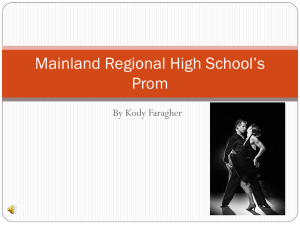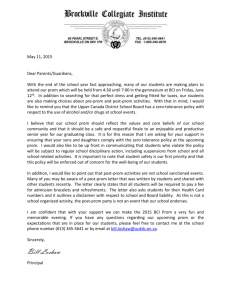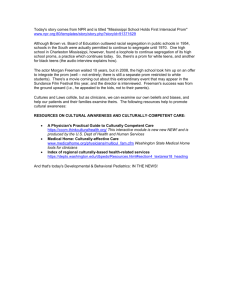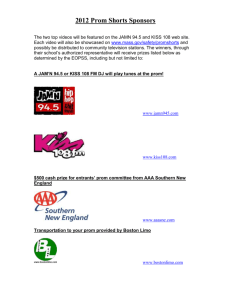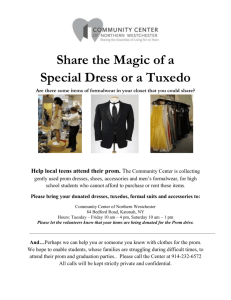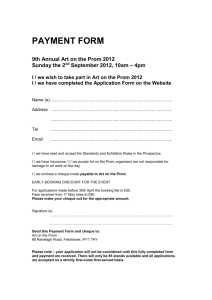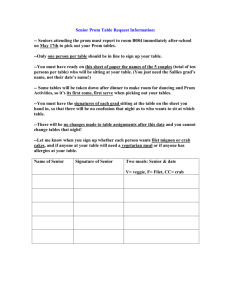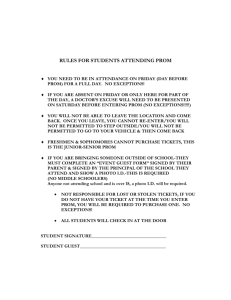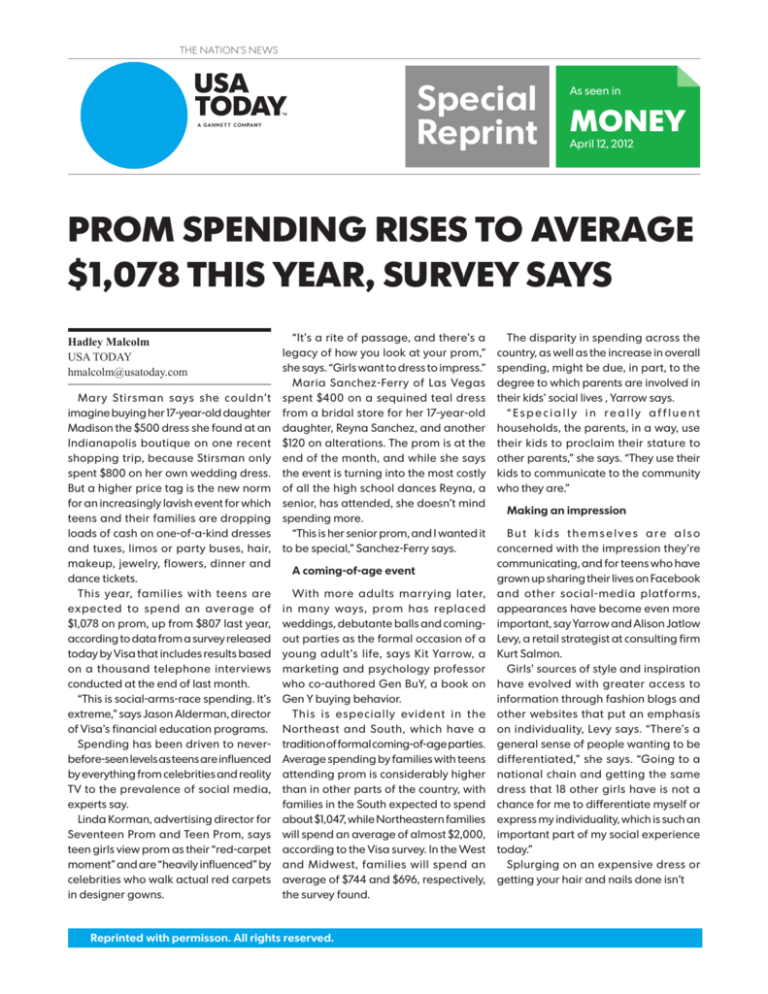
THE NATION’S NEWS
Special
Reprint MONEY
As seen in
April 12, 2012
PROM SPENDING RISES TO AVERAGE
$1,078 THIS YEAR, SURVEY SAYS
Hadley Malcolm
USA TODAY
hmalcolm@usatoday.com
Mary Stirsman says she couldn’t
imagine buying her 17-year-old daughter
Madison the $500 dress she found at an
Indianapolis boutique on one recent
shopping trip, because Stirsman only
spent $800 on her own wedding dress.
But a higher price tag is the new norm
for an increasingly lavish event for which
teens and their families are dropping
loads of cash on one-of-a-kind dresses
and tuxes, limos or party buses, hair,
makeup, jewelry, flowers, dinner and
dance tickets.
This year, families with teens are
expected to spend an average of
$1,078 on prom, up from $807 last year,
according to data from a survey released
today by Visa that includes results based
on a thousand telephone interviews
conducted at the end of last month.
“This is social-arms-race spending. It’s
extreme,” says Jason Alderman, director
of Visa’s financial education programs.
Spending has been driven to neverbefore-seen levels as teens are influenced
by everything from celebrities and reality
TV to the prevalence of social media,
experts say.
Linda Korman, advertising director for
Seventeen Prom and Teen Prom, says
teen girls view prom as their “red-carpet
moment” and are “heavily influenced” by
celebrities who walk actual red carpets
in designer gowns.
“It’s a rite of passage, and there’s a
legacy of how you look at your prom,”
she says. “Girls want to dress to impress.”
Maria Sanchez-Ferry of Las Vegas
spent $400 on a sequined teal dress
from a bridal store for her 17-year-old
daughter, Reyna Sanchez, and another
$120 on alterations. The prom is at the
end of the month, and while she says
the event is turning into the most costly
of all the high school dances Reyna, a
senior, has attended, she doesn’t mind
spending more.
“This is her senior prom, and I wanted it
to be special,” Sanchez-Ferry says.
A coming-of-age event
With more adults marrying later,
in many ways, prom has replaced
weddings, debutante balls and comingout parties as the formal occasion of a
young adult’s life, says Kit Yarrow, a
marketing and psychology professor
who co-authored Gen BuY, a book on
Gen Y buying behavior.
This is especially evident in the
Northeast and South, which have a
tradition of formal coming-of-age parties.
Average spending by families with teens
attending prom is considerably higher
than in other parts of the country, with
families in the South expected to spend
about $1,047, while Northeastern families
will spend an average of almost $2,000,
according to the Visa survey. In the West
and Midwest, families will spend an
average of $744 and $696, respectively,
the survey found.
The disparity in spending across the
country, as well as the increase in overall
spending, might be due, in part, to the
degree to which parents are involved in
their kids’ social lives , Yarrow says.
“Especially in really affluent
households, the parents, in a way, use
their kids to proclaim their stature to
other parents,” she says. “They use their
kids to communicate to the community
who they are.”
Making an impression
But kids themselves are also
concerned with the impression they’re
communicating, and for teens who have
grown up sharing their lives on Facebook
and other social-media platforms,
appearances have become even more
important, say Yarrow and Alison Jatlow
Levy, a retail strategist at consulting firm
Kurt Salmon.
Girls’ sources of style and inspiration
have evolved with greater access to
information through fashion blogs and
other websites that put an emphasis
on individuality, Levy says. “There’s a
general sense of people wanting to be
differentiated,” she says. “Going to a
national chain and getting the same
dress that 18 other girls have is not a
chance for me to differentiate myself or
express my individuality, which is such an
important part of my social experience
today.”
Splurging on an expensive dress or
getting your hair and nails done isn’t
Reprinted with permisson. All rights reserved. USA TODAY
April 12, 2012
MONEY
Special Reprint
Prom spending rises to average $1,078 this year, survey says
just about personal expression; it’s about
getting attention, Yarrow says.
“The bar is higher for what it takes
to get attention, and therefore, (teens)
really need to have something exclusive,
original, unique to them in order to get
attention to from other people,” Yarrow
says, and that often comes with a higher
price tag.
The “peer pressure to one up each other
over and over,” as Alderman says, seems
to be affecting less affluent families the
most. Parents in one of the lowest income
brackets from the Visa survey reported
planning to spend the most on prom.
Those who make between $20,000 and
$29,999 a year will spend more than
$2,600, twice the national average, while
families in high income brackets plan to
spend between $700 and $1,000.
“Appearance is everything, and for
prom, appearance really matters,”
Levy says. “You’ll probably see people
spending a little beyond their means to
make the right impression. It’s like your
Cinderella night, so you pull out all the
stops.”
Prom gets pricey
Hair
Tickets
$50
$20-$50
Prom expenses don’t end with the
dress or tuxedo. When you add in
limo rides, professional hair and
makeup services, visits to the nail
salon, new shoes and jewelry,
the hefty bill for this teenage rite
of passage keeps climbing,
according to a survey of readers
of Seventeen Prom and TeenPROM
magazines last year and a survey
from Visa. Average costs include:
Hair
accessories
$16.50
Jewelry
$32
Tuxedo1
Makeup
$33
$227
Dress
$231
Fragrance
$22
Handbag
$23
Corsage
$20
Transportation (8-10 hours)
Party bus: $171 per hour
Holds 15–30 people
Super Stretch limo: $125 per hour
Holds 15–24 people
Stretch SUV: $142 per hour
Holds 15–24 people
Nails
$35
Boutonniere
$10
Dinner
$75
Lingerie/
hosiery
$26
Estimated 2012 spending
$1,078
up $271 from
2011 average of $807
Shoes
$45
1 — Tuxedo price
includes tie, shoes
and cumberbund
Figures above are average costs from last year’s survey. Reporter Hadley
Malcolm, right, poses in her original senior year prom dress from 2007
(Actual cost: $120) with USA TODAY’s Tech web producer Charlie Szold.
Sources: Visa, Seventeen Magazine, Limousine, Charter & Tour Magazine,
Thinkstock.com, USA TODAY research
By Hadley Malcolm, Kate Patterson,
Jerry Mosemak and Kris Kinkade, USA TODAY
Reprinted with permisson. All rights reserved. Page 2
PROM SPENDING RISES TO AVERAGE
$1,078 THIS YEAR, SURVEY SAYS
Common Core State Standards
Anchor Standards for Reading:
q Read closely to determine what the text says explicitly and to make logical inferences from it; cite
specific textual evidence when writing or speaking to support conclusions drawn from the text.
q Interpret words and phrases as they are used in a text, including determining technical, connotative
and figurative meanings and analyze how specific word choices shape meaning or tone.
q Delineate and evaluate the argument and specific claims in a text, including the validity of the reasoning as well as the relevance and sufficiency of the evidence.
Anchor Standards for Writing:
q Produce clear and coherent writing in which the development, organization and style are
appropriate to task, purpose and audience.
National Standards in K–12 Personal Finance Education:
q Find and evaluate financial information from a variety of sources.
q Make financial decisions by systematically considering alternatives and consequences.
q Develop a plan for spending and saving.
q Apply consumer skills to purchase decisions.
Objectives
Students will:
q Read USA TODAY’s article Prom spending rises to average $1,078 this year, survey says.
q Discuss social and economic factors that impact the significant increase in prom expenses across
the United States.
q Identify the long-range effects of high, short-term spending.
q Estimate expenses for attending prom.
q Research ways to decrease expenses for prom this year..
Time Requirement: 55 minutes
Materials
Each student will need:
q A copy of USA TODAY’s article Prom spending rises to average $1,078 this year, survey says.
q A writing utensil.
q A copy of the worksheet, ‘Do the math’
q Access to the Internet, copies of the local newspaper or both.
EDUCATION
© Copyright 2013 USA TODAY, a division of Gannett
Page
Co., Inc.
3
PROM SPENDING RISES TO AVERAGE
$1,078 THIS YEAR, SURVEY SAYS
Read and Respond
Before handing out the article, ask students to quickly calculate how much they are planning to spend on
prom (or, if they are not attending prom, how much they think would be a reasonable amount to spend)? Remind students to consider costs such as: dance tickets, dinner, tuxedo, dress, hair, corsage and boutonniere.
List the amounts students share on the board from lowest to highest and figure the average amount of money
students plan spend on prom for your class.
Now, pass out copies of USA TODAY’s article and lesson worksheets to students. Read the article together and
direct students to answer the discussion questions using evidence from the text. You may want students to
respond to the questions in writing before leading a discussion.
1. What does the phrase “prom is the new wedding” mean?
2. B
ased on inferences in the article, why do you think prom expenditures increased by nearly 34% in one year?
3. Do you think the reasons behind the spending increase for prom were conscious? Or sub-conscious? 4. What factors explain the fact that average prom expenses differ drastically in different parts of
the United States?
5. How does social media affect prom spending?
6. How could spending a lot on prom impact families in six months or a year after prom?
Apply: Do the math
Ask a student to read aloud the introduction on the ‘Do the math’ worksheet:
Some families in the Visa survey say that they spend more than 10% of their annual income on prom for their
children. An expert said that showcasing one’s individuality is important when shopping for prom. Is it
possible to make your prom dreams come true at an economical cost?
Place students in pairs or direct students to choose a partner in order to complete the ‘Do the math’ worksheet.
Closing
Ask students to respond to the following questions. You may want to facilitate a group discussion or direct
students to respond in writing.
q What ways did you find to save money on this year’s prom?
q Is spending a lot of money on prom worth it? Explain.
q How can saving money on prom now benefit you in the long run?
EDUCATION
© Copyright 2013 USA TODAY, a division of Gannett
Page
Co., Inc.
4
PROM SPENDING RISES TO AVERAGE
$1,078 THIS YEAR, SURVEY SAYS
Do the math
Some families in the Visa survey say that they spend more than 10% of their annual income on prom for their children. An expert said that showcasing one’s individuality is important when shopping for prom. Is it
possible to make your prom dreams come true at an economical cost?
First, create a budget that identifies what you plan to spend on each item.
Next, pair up with another student and research ways to save on your overall total expenses. Can you find a great
dress secondhand? If four or five guys go together to rent tuxes, can you get a deal like one tux free (and split the
savings)? Are there restaurant coupons available?
Finally, total your cost savings and share at least one idea with your classmates.
Prom item
Estimated cost
After-savings cost
Savings method
Clothing
Shoes
Hair & makeup
Corsage
Transportation
Dinner
Tickets
Other
Total
EDUCATION
© Copyright 2013 USA TODAY, a division of Gannett
Page
Co., Inc.
5


